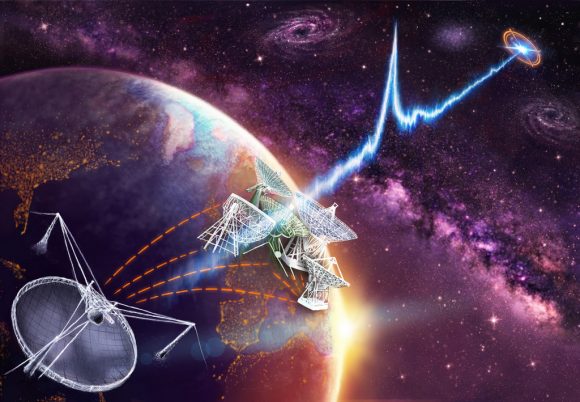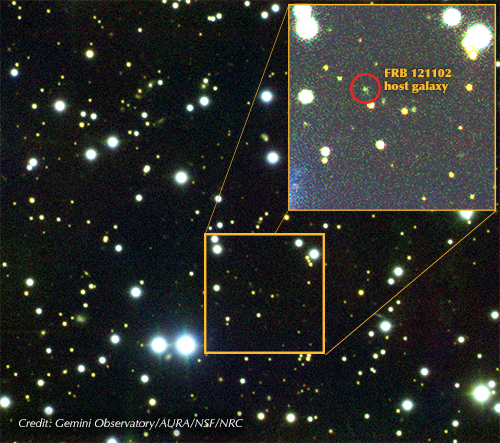For about 10 years, radio astronomers have been detecting mysterious milliseconds-long blasts of radio waves, called “fast radio bursts” (FRB).
While only 18 of these events have been detected so far, one FRB has been particularly intriguing as the signal has been sporadically repeating. First detected in November 2012, astronomers didn’t know if FRB 121102 originated from within the Milky Way galaxy or from across the Universe.
A concentrated search by multiple observatories around the world has now determined that the signals are coming from a dim dwarf galaxy about 2.5 billion light years from Earth. But astronomers are still uncertain about exactly what is creating these bursts.
“These radio flashes must have enormous amounts of energy to be visible from that distance,” said Shami Chatterjee from Cornell University, speaking at a press briefing at the American Astronomical Society meeting this week. Chatterjee and his colleagues have papers published today in Nature and Astrophysical Journal Letters.

The patch of the sky where the signal originated is in the constellation Auriga, and Chatterjee said the patch of the sky is arc minutes in diameter. “In that patch are hundreds of sources. Lots of stars, lots of galaxies, lots of stuff,” he said, which made the search difficult.
The Arecibo radio telescope, the observatory that originally detected the event, has a resolution of three arc minutes or about one-tenth of the moon’s diameter, so that was not precise enough to identify the source. Astronomers used the Very Large Array in New Mexico and the European Very Large Baseline Interferometer (VLBI) network, to help narrow the origin. But, said co-author Casey Law from the University of California Berkeley, that also created a lot of data to sort through.
“It was like trying to find a needle in a terabyte haystack,” he said. “It took a lot of algorithmic work to find it.”
Finally on August 23, 2016, the burst made itself extremely apparent with nine extremely bright bursts.
“We had struggled to be able to observe the faintest bursts we could,” Law said, “but suddenly here were nine of the brightest ones ever detected. This FRB was generous to us.”
The team was not only able to pinpoint it to the distant dwarf galaxy, co-author Jason Hessels from ASTRON/University of Amsterdam said they were also able to determine the bursts didn’t come from the center of the galaxy, but came from slightly off-center in the galaxy. That might indicate it didn’t originate from a central black hole. Upcoming observations with the Hubble Space Telescope might be able to pinpoint it even further.

What makes this source burst repeatedly?
“We don’t know yet what caused it or the physical mechanism that makes such bright and fast pulses,” said said Sarah Burke-Spolaor, from West Virginia University. “The FRB could be outflow from an active galactic nuclei (AGN) or it might be more familiar, such as a distant supernova remnant, or a neutron star.”
Burke-Spolaor added that they don’t know yet if all FRBs are created equal, as so far FRB 121102 is the only repeater. The team hopes there will be other examples detected.
“It may be a magnetar – a newborn neutron star with a huge magnetic field, inside a supernova remnant or a pulsar wind nebula – somehow producing these prodigious pulses,” said Chatterjee. “Or, it may be a combination of all these ideas – explaining why what we’re seeing may be somewhat rare.”
For additional reading:
Gemini Observatory
Berkeley
Nature
Nature News

